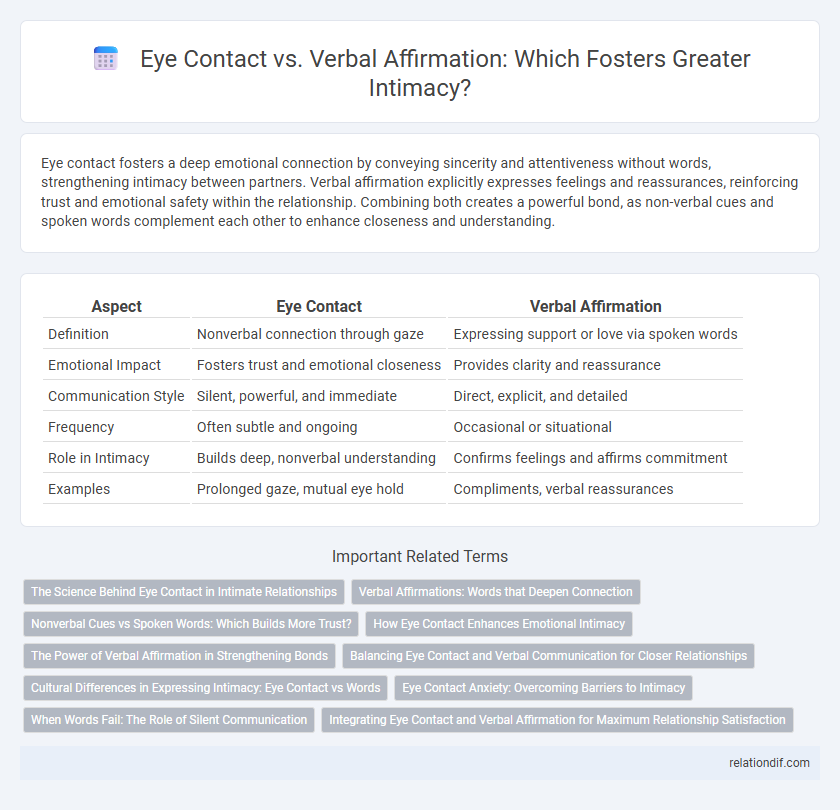Eye contact fosters a deep emotional connection by conveying sincerity and attentiveness without words, strengthening intimacy between partners. Verbal affirmation explicitly expresses feelings and reassurances, reinforcing trust and emotional safety within the relationship. Combining both creates a powerful bond, as non-verbal cues and spoken words complement each other to enhance closeness and understanding.
Table of Comparison
| Aspect | Eye Contact | Verbal Affirmation |
|---|---|---|
| Definition | Nonverbal connection through gaze | Expressing support or love via spoken words |
| Emotional Impact | Fosters trust and emotional closeness | Provides clarity and reassurance |
| Communication Style | Silent, powerful, and immediate | Direct, explicit, and detailed |
| Frequency | Often subtle and ongoing | Occasional or situational |
| Role in Intimacy | Builds deep, nonverbal understanding | Confirms feelings and affirms commitment |
| Examples | Prolonged gaze, mutual eye hold | Compliments, verbal reassurances |
The Science Behind Eye Contact in Intimate Relationships
Eye contact strengthens intimacy by activating the brain's social bonding pathways, increasing oxytocin levels and promoting emotional connection. Neuroscientific studies reveal that sustained gaze enhances trust and empathy between partners, engaging mirror neurons and fostering nonverbal communication. This physiological response often surpasses verbal affirmation in conveying genuine affection and understanding within intimate relationships.
Verbal Affirmations: Words that Deepen Connection
Verbal affirmations play a crucial role in deepening intimacy by articulating feelings that eye contact alone may not fully convey. Expressive words such as "I appreciate you" or "You mean so much to me" reinforce emotional bonds and build trust. Consistent verbal affirmations enhance communication, making partners feel seen, valued, and understood on a profound level.
Nonverbal Cues vs Spoken Words: Which Builds More Trust?
Eye contact serves as a powerful nonverbal cue that fosters trust by conveying sincerity, attentiveness, and emotional connection in intimate relationships. While spoken words offer explicit verbal affirmation, consistent and genuine eye contact often creates a deeper sense of understanding and reliability beyond what language alone can achieve. Studies show that nonverbal communication, particularly eye contact, can enhance emotional bonding and trust more effectively than verbal affirmations.
How Eye Contact Enhances Emotional Intimacy
Eye contact deepens emotional intimacy by creating a powerful nonverbal connection that communicates trust, vulnerability, and presence more effectively than verbal affirmation alone. Sustained eye contact activates mirror neurons, fostering empathy and mutual understanding, which strengthens the emotional bond between partners. This silent exchange often conveys sincerity and emotional depth that words may fail to express.
The Power of Verbal Affirmation in Strengthening Bonds
Verbal affirmation holds significant power in strengthening intimacy by clearly expressing appreciation and love, which deepens emotional connection beyond what eye contact alone can achieve. Phrases of encouragement and reassurance foster trust and security, reinforcing the bond between partners in a tangible way. Consistent verbal affirmations create a foundation of emotional safety, essential for enduring and resilient relationships.
Balancing Eye Contact and Verbal Communication for Closer Relationships
Balancing eye contact and verbal affirmation enhances emotional intimacy by reinforcing trust and understanding between partners. Eye contact conveys genuine attention and nonverbal connection, while verbal affirmation provides clear expressions of appreciation and support. Combining these communication methods fosters deeper relational bonds and helps partners feel valued and emotionally secure.
Cultural Differences in Expressing Intimacy: Eye Contact vs Words
Cultural differences significantly influence how intimacy is expressed through eye contact versus verbal affirmation, with Western cultures often emphasizing direct eye contact as a sign of trust and emotional closeness. In contrast, many Asian cultures may consider prolonged eye contact intrusive or disrespectful, relying more heavily on spoken words or subtle verbal affirmations to convey intimacy. Understanding these cultural nuances is essential for effectively interpreting and expressing intimacy in diverse social contexts.
Eye Contact Anxiety: Overcoming Barriers to Intimacy
Eye contact anxiety can significantly hinder the development of intimacy by creating barriers to emotional connection and trust. While verbal affirmation communicates support, sustained eye contact fosters deeper non-verbal understanding and vulnerability essential for intimacy. Overcoming eye contact anxiety involves gradual exposure and mindfulness techniques that enhance comfort and authentic connection.
When Words Fail: The Role of Silent Communication
Eye contact serves as a powerful form of silent communication that often conveys deeper intimacy than verbal affirmation. When words fail, sustained gaze can express trust, understanding, and emotional connection, creating an unspoken bond between partners. This nonverbal cue strengthens relationships by facilitating empathy and reinforcing feelings without spoken language.
Integrating Eye Contact and Verbal Affirmation for Maximum Relationship Satisfaction
Integrating eye contact with verbal affirmation significantly enhances intimacy by fostering deeper emotional connection and trust between partners. Consistent eye contact during affirmations conveys sincerity and attentiveness, amplifying the impact of spoken words on relationship satisfaction. Research shows couples who combine nonverbal cues like eye contact with verbal support report higher levels of emotional fulfillment and communication effectiveness.
Eye contact vs verbal affirmation Infographic

 relationdif.com
relationdif.com